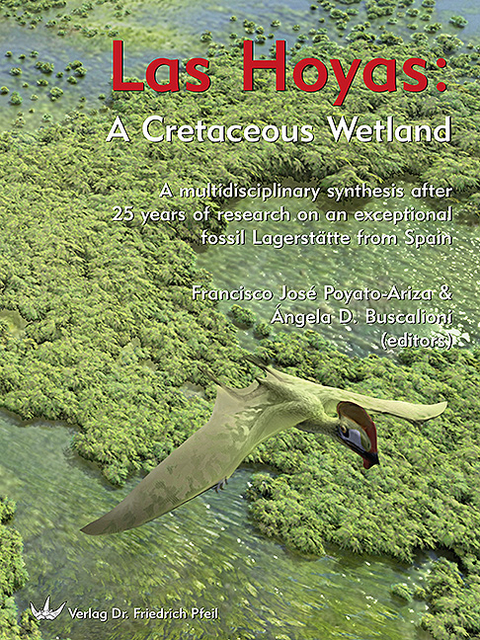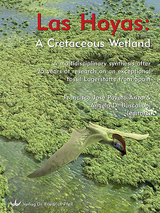Las Hoyas: A Cretaceous Wetland
Much or little was made in these 25 years, depending on how one looks at it. Either way, this synthesis volume aims to convey the story of our experience in the study of Las Hoyas. The present book is aimed to both specialists and informed aficionados. It incorporates many international researchers who have largely contributed to the understanding of the palaeobiology and taphonomy of this locality. The volume is organized into four major parts. Part I is devoted to the Las Hoyas environment by providing the geological framework to understand how the interpretation of this fossil Lagerstätte has changed from a deep lake at first to the current hypothesis of a shallow aquatic environment made of a mosaic of pools, filled by microbial mats, in a wetland-like landscape. Part II unfolds the palaeobiology of the different groups of plants and animals recorded at Las Hoyas by providing an updated revision of their taxonomic diversity. The information provided for each group is presented in a homogeneous manner by developing a summarized description of the specimens, their life styles and ecomorphology, phylogenetic context, preservation, and relevance of the Las Hoyas record within a worldwide or European frame. The processes involved in the fossil preservation are explored in Part III. This part includes not only the study of the preservation of the fossils themselves, but also some chapters devoted to experimental taphonomy and the role of microbial mats in preservation. Part IV incorporates our experience in the fieldwork in establishing how palaeoecological restorations need of a previous taphonomic study. The final chapter presents restorations by some brilliant young artists of the landscape and organisms living in the Las Hoyas Wetland during the Early Cretaceous in the framework of their trophic network. An Addendum incorporates taxa discovered or described during the elaboration of the present volume, and a final Appendix presents an updated taxonomic classification of the biota from Las Hoyas.
We wish to emphasize the idea that Las Hoyas is a laboratory of Natural History where new questions are continuously emerging: How was the site generated? What conditions were present, resulting on such abundance and exceptional preservation? What were the modes of life of those extinct organisms? What relevance has it all from an evolutionary point of view? Knowledge of the past does not always involve explaining the future, but sets the way in which it originated and shaped the present. Fossils will always be the key to unveil the History of Life on Earth.
Dr. Ana María BÁEZ Paleontología Evolutiva de Vertebrados, Departamento de Ciencias Geológicas, Universidad de Buenos Aires, Buenos Aires, Argentina Dr. Arnau BOLET Institut Català de Paleontología, Universitat Autònoma de Barcelona, Spain Dr. Geoff A. BOXSHALL Department of Palaeontology, The Natural History Museum, London, UK Dr. Derek E. G. BRIGGS Department of Geology and Geophysics, and Peabody Museum of Natural History, Yale University, New Haven, Connecticut, USA Dr. Luis A. BUATOIS Department of Geological Sciences, University of Saskatchewan, Saskatoon, Canada Dr. Ángela D. BUSCALIONI Unidad de Paleontología, Departamento de Biología, Universidad Autónoma de Madrid, Spain Dr. Óscar CAMBRA MOO Laboratorio de Poblaciones del Pasado (LAPP), Departamento de Biología, Universidad Autónoma de Madrid, Spain Dr. Beatriz CHAMERO Unidad de Paleontología, Departamento de Biología, Universidad Autónoma de Madrid, Spain Dr. Luis M. CHIAPPE The Dinosaur Institute, Natural History Museum of Los Angeles County, Los Angeles, CA, USA Dr. Véronique DAVIERO-GOMEZ CNRS-UMR 5276 and Université Lyon 1 (Claude Bernard), Campus de La Doua, Villeurbanne, France Dr. Xavier DELCLÒS Departament de Dinàmica de la Terra i de l’Oceà, Facultat de Ciències de la Terra, Universitat de Barcelona, Spain Dr. Graciela DELVENE Museo Geominero, Instituto Geológico y Minero de España, Madrid, Spain Dr. Fernando ESCASO Grupo de Biología, Facultad de Ciencias, Universidad Nacional de Educación a Distancia, Madrid, Spain Dr. Susan E. EVANS Research Department of Cell and Developmental Biology, University College, London, UK Dr. Marian FREGENAL MARTÍNEZ Departamento de Estratigrafía. Facultad de Ciencias Geológicas & Instituto de Geociencias (UCM-CSIC), Universidad Complutense de Madrid, Spain Dr. Marcelo S. de la FUENTE Departamento de Paleontología, Museo de Historia Natural de San Rafael, San Rafael, Mendoza, Argentina Montserrat de la FUENTE Seksjon for Naturhistorie, Vitenskapsmuseet, Norges Teknisk-Naturvitenskapelige Universitet (NTNU). Trondheim, Norge Dr. Alessandro GARASSINO Department of Invertebrate Paleontology, Natural History Museum, Milano, Italy Dr. Jordi M. de GIBERT† Departament d’Estratigrafia, Paleontologia i Geociències Marines, Universitat de Barcelona, Spain Dr. Bernard GOMEZ CNRS-UMR 5276 and Université Lyon 1 (Claude Bernard), Campus de La Doua, Villeurbanne, France Dr. Neal S. GUPTA CEdR/academic, Roslindale, Boston, MA, USA. Dr. Maria del Carmen GUERRERO Departamento de Ecología, Laboratorio de Ecología Microbiana, Universidad Autónoma de Madrid, Spain Dr. Miguel INIESTO Departamento de Ecología, Laboratorio de Ecología Microbiana, Universidad Autónoma de Madrid, Spain Dr. Damià JAUME Instituto Mediterráneo de Estudios Avanzados, CSIC, Universitat de les Illes Balears, Esporles, Illes Balears, Spain Dr. Jennifer A. LANE Bayerische Staatssammlung für Paläontologie und Geologie, Munich, Germany Mercedes LLANDRÉS SERRANO Museo de las Ciencias de Castilla-La Mancha, Cuenca, Spain Dr. Ana Isabel LÓPEZ ARCHILLA Departamento de Ecología, Laboratorio de Ecología Microbiana, Universidad Autónoma de Madrid, Spain Álvaro LÓPEZ GARCÍA Departamento de Biología, Universidad Autónoma de Madrid, Spain Dr. John G. MAISEY Department of Vertebrate Paleontology, American Museum of Natural History, New York, USA Dr. M. Gabriela MÁNGANO Department of Geological Sciences, University of Saskatchewan, Saskatoon, Canada Dr. Hugo MARTÍN ABAD Unidad de Paleontología, Departamento de Biología, Universidad Autónoma de Madrid, Spain Dr. Carles MARTÍN CLOSAS Department d’Estratigrafia, Paleontologia i Geociències Marines, Facultat de Geologia, Universitat de Barcelona, Spain Dr. Jesús MARUGÁN LOBÓN Unidad de Paleontología, Departamento de Biología, Universidad Autónoma de Madrid, Spain Dr. Nieves MELÉNDEZ Departamento de Estratigrafía. Facultad de Ciencias Geológicas & Instituto de Geociencias (UCM-CSIC), Universidad Complutense de Madrid, Spain Carlos de MIGUEL Departamento de Biología, Universidad Autónoma de Madrid, Spain Dr. José J. MORATALLA Museo Geominero, Instituto Geológico y Minero de España, CSIC, Madrid, Spain Dr. Martin Clive MUNT Department of Palaeontology, The Natural History Museum, London, UK Guillermo NAVALÓN FERNÁNDEZ Unidad de Paleontología, Departamento de Biología, Universidad Autónoma de Madrid, Spain Dr. Jingmai K. O’CONNOR Key Laboratory of Evolutionary Systematics of Vertebrates, Institute of Vertebrate Paleontology and Paleoanthropology, Beijing, People’s Republic of China Dr. Francisco ORTEGA Grupo de Biología Evolutiva, Facultad de Ciencias, Universidad Nacional de Educación a Distancia, Madrid, Spain Dr. Adán PÉREZ GARCÍA Grupo de Biología Evolutiva, Facultad de Ciencias, Universidad Nacional de Educación a Distancia, Madrid, Spain Eva PINARDO MOYA Unidad de Paleontología, Departamento de Biología, Universidad Autónoma de Madrid, Spain Dr. Francisco José POYATO ARIZA Departamento de Biología, Universidad Autónoma de Madrid, Spain Dr. Julio RODRÍGUEZ LÁZARO Departamento de Estratigrafía y Paleontología, Facultad de Ciencia y Tecnología, Universidad del País Vasco, Bilbao, Spain Dr. Óscar SANISIDRO Departamento de Paleobiología, Museo Nacional de Ciencias Naturales, CSIC, Madrid, Spain Dr. José Luis SANZ Unidad de Paleontología, Departamento de Biología, Universidad Autónoma de Madrid, Spain Dr. Paul A. SELDEN Paleontological Institute and Department of Geology, University of Kansas, Lawrence, Kansas, USA & The Natural History Museum, London, UK Dr. William A. SHEAR Department of Biology, Hampden-Sydney College, Hampden-Sydney, Virginia, USA Dr. Rodrigo SOLER GIJÓN Museum für Naturkunde, Humboldt University, Berlin, Germany & Departamento de Paleontología, Facultad de Ciencias Geológicas, Universidad Complutense de Madrid, Spain Dr. Carmen SORIANO ESRF (European Synchrotron Radiation Facility), Grenoble, France Dr. Romain VULLO Laboratoire de Paléontologie, Géosciences, UMR CNRS 6118, Université de Rennes 1, Rennes, France Dr. Reinhard ZETTER Abteilung Paläobotanik, Institut für Paläontologie, Universität Wien, Vienna, Austria
Contributors (authors)6-7
Acknowledgements8
Preface: a bit of history (Francisco José Poyato-Ariza and Ángela D. Buscalioni)9-12
IIntroduction
I.1Relevance of Las Hoyas as a Mesozoic Lagerstätte (Ángela D. Buscalioni and Francisco José Poyato-Ariza)13
I.2Environmental reconstruction: a historical review (Marian Fregenal-Martínez and Nieves Meléndez)14-28
IIFossil Record
II.1Las Hoyas in the Tree of Life (Francisco José Poyato-Ariza, Hugo Martín-Abad and Guillermo Navalón-Fernández)29-30
II.2Palynomorphs (Montserrat de la Fuente and Reinhard Zetter)31-42
II.3Plants and their landscapes (Carles Martín-Closas, Bernard Gomez and Véronique Daviero-Gomez)43-56
II.4Mollusca (Graciela Delvene and Martin Clive Munt)57-63
II.5Arachnida (Paul A. Selden)64-67
II.6Diplopoda (Paul A. Selden and William A. Shear)68-69
II.7Insecta (Xavier Delclòs and Carmen Soriano)70-88
II.8Ostracoda (Julio Rodríguez-Lázaro)89-93
II.9Spelaeogriphacea (Damiá Jaume, Eva Pinardo-Moya and Geoff A. Boxshall)94-97
II.10Decapoda (Alessandro Garassino)98-102
II.11Chondrichthyes (Rodrigo Soler-Gijón, Francisco José Poyato-Ariza, John G. Maisey and Jennifer A. Lane)103-113
II.12Osteichthyan fishes (Francisco José Poyato-Ariza and Hugo Martín-Abad)114-132
II.13Albanerpetontidae (Susan E. Evans)133-137
II.14Urodela (Susan E. Evans)138-142
II.15Salientia (Ana María Báez)143-150
II.16Chelonia (Adán Pérez-García, Marcelo S. de la Fuente and Francisco Ortega)151-155
II.17Squamata (Susan E. Evans and Arnau Bolet)156-161
II.18Crocodylomorpha (Angela D. Buscalioni and Beatriz Chamero)162-169
II.19Pterosauria (Romain Vullo and Jesús Marugán-Lobón)170-174
II.20aDinosauria (Ornithischia) (Mercedes Llandres Serrano, Romain Vullo and Francisco Ortega)175-176
II.20bDinosauria (non-avian Saurischia) (Fernando Escaso, Francisco Ortega and José Luis Sanz)177-182
II.21Aves (José Luis Sanz, Beatriz Chamero, Luis M. Chiappe, Jesús Marugán-Lobón, Jingmai K. O’Connor, Francisco Ortega and Fernando Escaso)183-189
II.22Feathers (Jesús Marugán-Lobón and Romain Vullo)190-194
II.23Ichnoassemblage (trace fossils) (Jordi M. de Gibert, José J. Moratalla, M. Gabriela Mángano and Luis A. Buatois)195-201
IIITaphonomy
III.1Biostratinomic factors involved in fish preservation (Hugo Martín-Abad and Francisco José Poyato-Ariza)202-210
III.2Anuran biostratinomy (Álvaro López-García, Hugo Martín-Abad and Óscar Cambra-Moo)211-215
III.3Molecular preservation (Derek E. G. Briggs, Neal S. Gupta and Óscar Cambra-Moo)216-219
III.4Microbial mats and preservation (María del Carmen Guerrero, Ana Isabel López-Archilla and Miguel Iniesto)220-228
III.5Exceptional preservation (Francisco José Poyato-Ariza and Ángela D. Buscalioni)229-231
IVPalaeoecology
IV.1From Taphonomy to Palaeoecology (Angela D. Buscalioni and Francisco José Poyato-Ariza)232-237
IV.2The wetland of Las Hoyas (Ángela D. Buscalioni, Francisco José Poyato-Ariza, Jesús Marugán-Lobón, Marian Fregenal-Martínez, Óscar Sanisidro, Guillermo Navalón and Carlos de Miguel)238-253
Addendum 1: New taxa and some latest findings (compiled by the editors)254-257
Addendum 2: Spinolestes (compiled by the editors)256
Appendix: Systematic list258-259
Added in proof260-261
| Erscheinungsdatum | 06.10.2016 |
|---|---|
| Zusatzinfo | 41 Farb- und 1 Schwarzweißtafeln, 64 Farb- und 101 Schwarzweißabbildungen (insgesamt 838 Fotos, Zeichnungen und Grafiken), 13 Tabellen. |
| Sprache | englisch |
| Maße | 245 x 326 mm |
| Einbandart | gebunden |
| Themenwelt | Naturwissenschaften ► Geowissenschaften ► Mineralogie / Paläontologie |
| Schlagworte | fossils • Kreidezeit • Palaeontology |
| ISBN-10 | 3-89937-153-4 / 3899371534 |
| ISBN-13 | 978-3-89937-153-6 / 9783899371536 |
| Zustand | Neuware |
| Haben Sie eine Frage zum Produkt? |
aus dem Bereich




